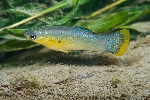Parallel shifts of visual sensitivity and body colouration in replicate populations of extremophile fish
Por Owens, Gregory L., Thor Veen, Dylan R. Moxley, Lenin Arias-Rodriguez, Michael Tobler, Diana J. Rennison
Molecular ecology, 16-nov.-2021. DOI: 10.1111/MEC.16279
" Visual sensitivity and body pigmentation are often shaped by both natural selection from the environment and sexual selection from mate choice. One way of quantifying the impact of the environment is by measuring how traits have changed after colonization of a novel habitat. To do this, we studied Poecilia mexicana populations that have repeatedly adapted to extreme sulphidic (H2S containing) environments. We measured visual sensitivity using opsin gene expression, as well as body pigmentation for populations in four independent drainages. Both visual sensitivity and body pigmentation showed significant parallel shifts towards greater medium wavelength sensitivity and reflectance in sulphidic populations. Altogether we found that sulphidic habitats select for differences in visual sensitivity and pigmentation. Shifts between habitats may be both due to differences in the water’s spectral properties and correlated ecological changes "
Clasificación: Ecología y conservación.
Idioma: English
Referencia en bibliografía de especies (1)
Owens, Gregory L. & Thor Veen, Dylan R. Moxley, Lenin Arias-Rodriguez, Michael Tobler, Diana J. Rennison. 2021. "Parallel shifts of visual sensitivity and body colouration in replicate populations of extremophile fish". Molecular ecology. DOI: 10.1111/MEC.16279 (ffm01042) (resumen)
